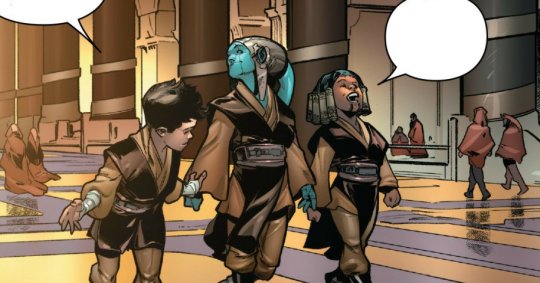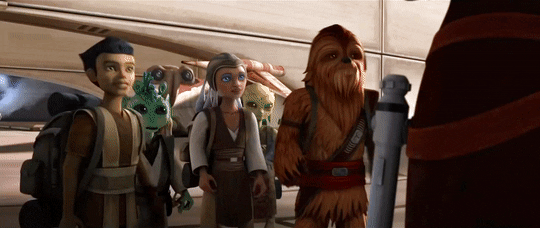#basically right after her entire creche arc
Text
uh guys? i have come up with a new bg3 pairing. it makes sense i swear, it does.
please brace yourself... for Lae'zel x Barcus Wroot.
#girl sees him getting disrespected by wulbren in act 2#basically right after her entire creche arc#and is incensed on his behalf#she'd go wtf and respect barcus for his intentions and gumption alone#barcus wroot#lae'zel#bg3#baldur's gate 3#crackship#rarepair#i swear on my life
7 notes
·
View notes
Photo







JEDI PADAWANS IN CANON: Surprisingly, we actually have very little about how the Jedi culture works in canon, though, we have the broad strokes of it, enough that I think you can get an idea of the general arc of things! This post will be based on canon, of course, as Canon and Legends are basically separate continuities, so stuff like “the Jedi age out at 13 if no one picks them as a Master” has never been evidenced in canon.
I also have TAKING A CLOSER LOOK AT THE JEDI IN CANON, a meta work on AO3 that’s been about collecting together and organizing everything I can find on the Jedi of canon, but let’s talk specifically about the path to becoming a Jedi Padawan!
THE PATH OF A YOUNGLING TO A JEDI:
YOUNGLING/INITIATE:
- The Jedi younglings are adopted generally in the age range of about three years old, give or take. It’s evidenced by Wee Dunn (the little Rodian boy that Cad Bane kidnapped) that there’s an adjustment period with the biological family (if the family wishes it), given that his bio-mom says, “Master Ropal said the day would come for him to go to the Temple, but not for some time.”
- The terms “Youngling” and “Initiate” seem relatively interchangeable?
- In Dooku: Jedi Lost, Dooku says: “Like most of the Order, I was brought to the Temple by a Seeker, a Jedi who was tasked to scour the galaxy for Force-sensitive infants.”
- “On arrival at the Temple, Initiates are sorted into clans, an arbitrary grouping in many ways, but one that is supposed to foster an atmosphere of trust and kinship.“ This seems to work pretty well, indicated by how even the very serious Dooku is like, “[....] by us and every other Initiate that likes to gossip by the light of a glow lantern late at night.” to show the lighter hearted aspects of the pile of younglings gossping at night. (Dooku: Jedi Lost)
- Not a ton is known about their time in the creche (which is indeed called the creche, according to M&A -- “[Qui-Gon]’d spent his last night in the younglings’ crèche laughing with his friends, imagining all the adventures he would have, and practicing with his lightsaber in the sparring room until Master Yaddle ordered him to bed.“) or what that means to their Jedi Path, other than that, at some point, they go on The Gathering to get their kyber crystal from Ilum, if they can pass the test of looking inward, facing their fears, and hearing the song of the crystal meant specifically for them.
This sacred ritual doesn’t seem to be tied to doing it with their Master, as The Clone Wars and the Age of the Republic comic show that they go in groups and are supervised by another Jedi (Ahsoka in the case of “The Gathering”, with Yoda there on Ilum, Huyang watching over the groups in both TCW and the comic), as well as the group of younglings (Katooni, Petro, Byph, Ganodi, and Gungi) are seen practicing with their lightsabers in Master Sinube’s class while Anakin and Barriss have their fight across the Temple roof.
- We see Yoda instructing the younglings in Attack of the Clones, but it’s unclear if they’re using their own lightsabers or training sabers (which the Temple has, according to Star Wars: Lightsabers - A Guide To Weapons of The Force. (I’m presuming that they’re training sabers, they look too young to be ready for The Gathering, but canon hasn’t specified either way.)
- We do get some broad strokes of the kind of schooling they have while they’re younglings:
- Jedi younglings (at least the diurnal ones) wake at dawn to meditate on the three pillars–the Force, Knowledge, and Self-Discipline. Then they go to the refectory for lunch, where Dooku always likes to sit next to Sifo-Dyas.
- Qui-Gon says, “Qui-Gon whispered, 'The dark side?' He knew it was a thing all beings carried within them, a part of himself he would learn to guard against—the crèche masters had taught him all that.” (Master & Apprentice) showing that the creche masters also taught them while they were there.
- They have group classes together, where we see teachers giving lessons on how to meditate or other philosophy lessons or how to connect to the Force (this is backed up by a lot of Kanan’s early teachings to Ezra, what he starts with as the foundations/basics), which presumably Padawans can still be part of, given that Qui-Gon still goes to classes after becoming Dooku’s Padawan. [x]
- They have regular classes and some of what we know are: Levitation classes, Force-Sculpting classes, Galactic History classes, Jedi History classes, Animal Kinship/Beast Control, and Unarmed Combat.
(”The duties of a Padawan varied greatly. Certain kinds of instruction were universal—meditation, lightsaber training—and were studied both in groups at the Temple and privately with one’s Master. But those Masters ranged widely in talents and temperament, which meant that the assignments they gave were diverse, too.” --Master & Apprentice)
- They have class field trips of some sort--Obi-Wan has a class of younglings (that Caleb is part of) on a field trip to teach them about the Jedi Beacon. While this seems to be within the Temple itself, we saw in Dooku: Jedi Lost that several younglings went with the Jedi to a Celebration Festival as part of a group who would do demonstrations for people, too.
- They’re given homework (Qui-Gon works on his while lounging in Dooku’s quarters) and have class projects (”Obi-Wan could scan nearly the entire lower level of the Jedi Archives. Jocasta Nu sat at her desk, patiently reviewing some file or other; a handful of younglings struggled through a dense historical holo, probably for a class project”) -- Master & Apprentice.
- Whatever Katooni and the others are doing in the beginning of “The Gathering” with the dance-style moves is unclear, whether it’s a class that Master Sinube is teaching or if it’s a ceremony of some kind that relates to the upcoming Gathering, who knows! But it’s clearly important and overlaid with the announcer saying, “The trials are hard. Tests must be passed. But none is as important as The Gathering. It is then that a Jedi’s path will truly begin….” (Though, this could be in reference to the trials they’re about to face on Ilum which are hard, rather than that the dance class is a trial, it’s never stated either way.) [x]
PADAWANS:
- There doesn’t seem to be anything on how Padawans are chosen as a usual path! In Dooku: Jedi Lost, there’s a ceremonial lightsaber tournament, but the wording never quite directly says that it’s specifically for Master to choose their Apprentices, as well as in Kanan: The Last Padawan, Depa directly asks young Caleb herself. In The Clone Wars movie, Anakin is assigned Ahsoka, which doesn’t seem to surprise either Obi-Wan (who may have planned this) or Anakin in the sense of “wait, they don’t just assign Padawans!”, only that she was being assigned to him.
Obi-Wan and Qui-Gon’s partnership seems to be a bit of both: “Don’t you see, Obi-Wan? They knew you’d rebel against any Master you worked with. So they made sure you wound up with a Jedi who almost never followed the rules.” (Master & Apprentice)
This seems to indicate that it happened in a myriad of ways, whether a Master took notice of a youngling at the tournament or bonded with them in another way or the Council decided to assign a pairing.
- When a youngling becomes a Padawan, there seems to be some conversations between the crechemasters and the new Master: “Obi-Wan said, 'You know, I never had problems with that as a youngling. Being independent, I mean. I broke rules right and left. They even called me rebellious. Probably the Masters were surprised anyone was willing to take me on as an apprentice.’ In fact, Qui-Gon had been warned about this very thing. He’d long since assumed that the crèche masters’ concern was overcautious.” (Master and Apprentice)
- There’s no set age when a Youngling becomes a Padawan.
- Dooku was 16 years old when Yoda chose him to be a Padawan, Sifo-Dyas was 16 when Lene Kostana chose him. For a brief while, Dooku didn’t think he would be chosen this year and would have to wait awhile longer, as well as another 16 year old Initiate wasn’t ready and did wind up having to wait another year. (Dooku: Jedi Lost)
- Obi-Wan was chosen at 13 and Qui-Gon at 12, but both were considered young for it. (Master & Apprentice)
- Caleb Dume was chosen at 13, but was also considered to be surprisingly young for it. (Kanan: The Last Padawan)
- Ahsoka was assigned at 14, but Anakin expressed surprise that she was even “old enough to be a Padawan!?” (The Clone Wars movie)
- Teaching seems to be a communal thing with the Jedi. While their Master is the final authority (in as much as anyone is an authority over someone else--Ahsoka argues and doesn’t really get that much pushback on how Master Skywalker isn’t the one who should decide when she risks her life, that’s her choice), we see Ahsoka is taught by Anakin, Obi-Wan, Yoda, Plo Koon, Aayla Secura, Luminara Unduli, Tera Sinube, and Jocasta Nu.
In The Citadel arc in TCW, Ahsoka says that Master Plo assigned her to the team, which Anakin doesn’t object to as being impossible because she’s his Padawan. Further, we also see communal teaching elements in Dooku: Jedi Lost when Lene is a frequent teacher to Dooku after he becomes Yoda’s Padawan.
JEDI KNIGHTS:
- While we never see any official Knighting ceremonies in the time of the Jedi Order, there are two examples post-Jedi Purge that use similar enough rituals that it’s a reasonably safe bet they were used by the Order as well:
- In Rebels “Shroud of Darkness”, when Kanan and Ezra and Ahsoka enter the Lothal Jedi Temple, he has to face a vision of the Grand Inquisitor revealing that he was once a Temple Guard. In facing him, Kanan passes the test, which was Yoda directing the vision (via behind the scenes commentary by Henry Gilroy) to give Kanan a trial, which he then uses the vision to gently sweep the lightsaber over Kanan and has the vision say, “By the right of the Council, by the will of the Force, Kanan Jarrus, you may rise. [....] It means you are what I once was. A Knight of the Jedi Order.” [x]
- In Jedi: Fallen Order, Cere Junda (once a Jedi Knight herself) tells Cal to kneel and makes the same gesture, sweeping the lightsaber over him, and says: "By the right of the Council, by the will of the Force, Cal Kestis. Rise, Jedi Knight." [x]
THAT’S IT, THAT’S PRETTY MUCH EVERYTHING WE KNOW ABOUT THE JEDI PADAWAN PATH. There’s really no one set way of doing things--“Every master trains their Padawan in their own way.“ (Jedi: Fallen Order)--but you can see the shape of how things are approached within the Jedi Culture!
#jedi order#anakin skywalker#obi wan kenobi#kanan jarrus#ahsoka tano#count dooku#qui gon jinn#meta#long post
780 notes
·
View notes